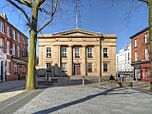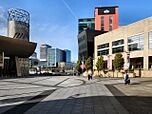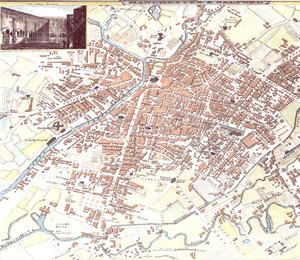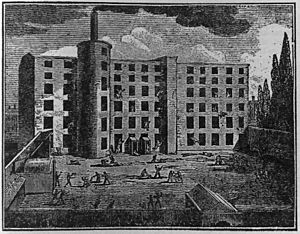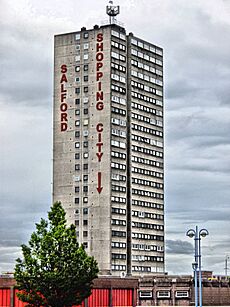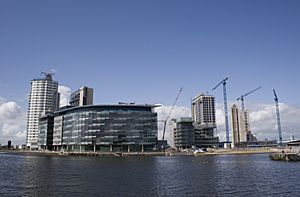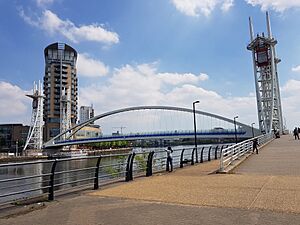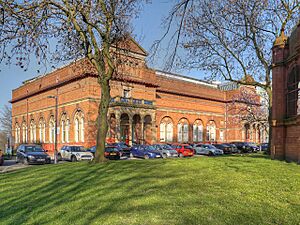Salford facts for kids
Quick facts for kids Salford |
|
|---|---|
| City | |
|
|
| Area | 8.1 sq mi (21 km2) |
| Population | 129,794 (2021 Census) |
| • Density | 8,981/sq mi (3,468/km2) |
| Demonym | Salfordian |
| OS grid reference | SJ805985 |
| • London | 164 mi (264 km) SE |
| Metropolitan borough | |
| Metropolitan county | |
| Region | |
| Country | England |
| Sovereign state | United Kingdom |
| Post town | SALFORD |
| Postcode district | M3, M5–M7, M50 |
| Dialling code | 0161 |
| Police | Greater Manchester |
| Fire | Greater Manchester |
| Ambulance | North West |
| EU Parliament | North West England |
| UK Parliament |
|
Salford is a city in Greater Manchester, England. It sits on the western side of the River Irwell, which separates it from Manchester city centre. Important places in Salford include the old Salford Town Hall, Salford Cathedral, and Salford Lads' Club. In 2021, about 129,794 people lived there. People from Salford are called Salfordians.
Salford is the main part of the larger City of Salford area. This wider area also includes towns like Eccles, Pendlebury, and Swinton. Salford is represented in the UK Parliament by an MP for the Salford constituency.
The name Salford comes from the Early Middle Ages. However, people have lived here since the Neolithic (New Stone Age) period. Salford was once a very important trading town. It was granted a special market charter around 1230. Later, during the Industrial Revolution, Manchester grew much bigger. Salford became a city in 1926. The current larger area was created in 1974.
In the 18th and 19th centuries, Salford was a major center for cotton and silk factories. It also became a busy inland port after Salford Docks opened in 1894. But in the 20th century, many industries closed down. This led to parts of the city becoming run-down. Since the 1930s, Salford has been rebuilt and improved. From 2007, many media companies, like the BBC, moved to MediaCityUK in Salford Quays. This area was built on old docklands. Other important places in Salford include the University of Salford and Salford City Football Club.
Contents
- Exploring Salford's Past: A Journey Through Time
- The Rise of Industry: Salford's Transformation
- Modern Salford: Decline and Rebirth
- How Salford is Governed
- Salford's Location and Landscape
- People of Salford: Demographics
- Iconic Places: Landmarks in Salford
- Getting Around: Transport in Salford
- Learning and Culture: Education and Institutions
- Faith and Community: Religion in Salford
- Sporting Spirit: Sports in Salford
- Creative Corner: Culture in Salford
- Community Support: Public Services
- Famous Faces: Notable People from Salford
- See also
Exploring Salford's Past: A Journey Through Time
What's in a Name? The Meaning of Salford
The name Salford comes from an old English word, Sealhford. This means "ford by the willows". A ford is a shallow place in a river where you can cross. Willow trees used to grow along the banks of the River Irwell where the ford was. This crossing point was near where Victoria Bridge is today.
Ancient Roots: Early Settlements in Salford
The oldest signs of people living in Salford are Neolithic flint arrowheads. These were found on Kersal Moor and near the River Irwell. They suggest people lived here 7,000 to 10,000 years ago. Other ancient tools and pots have also been found.
The Brigantes were a powerful Celtic tribe in Northern England. Their main fort was across the river from Salford's original center. After the Roman conquest of Britain, the Romans built a fort called Mamucium (Manchester) in AD 79. This fort protected important roads. Salford began when this fort was finished. Roman roads ran through what is now Salford, but few Roman items have been found.
After the Romans left in AD 410, the Saxons settled here. Later, the Danes took over. The Angles gave the area the name Sealhford. In 923, Edward the Elder conquered the area.
Royal Connections: Salford's Medieval History
After England became a united kingdom, Salford was an important manor. It was part of the Hundred of Salford, a large area managed for military and legal reasons. This area was much bigger than today's city.
After the Norman conquest of England, William I gave the Hundred of Salford to Roger the Poitevin. The Domesday Book of 1086 shows the Hundred of Salford covered a large area with 35,000 people. Roger lost the manor in 1102. Around 1115, Henry I gave the Hundred of Salford to the Earl of Lancaster. This made Salford a royal manor.
Salford started to grow as a small town in the early 1200s. In 1228, Henry III allowed Salford to hold a market and an annual fair. These fairs were very important for trade. In 1230, Ranulf de Blondeville, 6th Earl of Chester made Salford a "free borough." This gave its citizens special trading rights. This encouraged important families to move to Salford. By the Late Middle Ages, Salford had many grand houses, like Ordsall Hall.
During the English Civil War (1640–49), Salford supported the King, while Manchester supported Parliament. This caused some tension between the two towns. Later, in 1745, Salford strongly supported Bonnie Prince Charlie in his attempt to become King.
The Rise of Industry: Salford's Transformation
Textile Power: Mills and Factories
Salford had a long history of making textiles even before the Industrial Revolution. People made woolen goods and other fabrics at home. The Industrial Revolution changed Salford greatly. Factories replaced home-based work, and the population grew very fast.
The River Irwell provided water power, attracting business owners to build cotton mills. Early mills used water power, but with the invention of the steam engine in the late 1700s, mills could be built closer to towns. This meant they were near workers and coal. Philip's and Lee's Twist Mill, built in 1801, was one of the first large factories to use gas lighting. Many engineering companies also started here.
Waterways and Trade: Canals and Docks
Canals also helped Salford grow. The Bridgewater Canal, opened in 1761, made it cheaper to transport coal and raw materials. The Manchester, Bolton & Bury Canal also brought cheap coal.
The biggest change came with the Manchester Ship Canal, which opened in 1894. This turned Salford into a major inland port. Salford Docks provided jobs for over 3,000 workers. By 1914, the Port of Manchester, mostly in Salford, was one of the world's largest ports. It handled a lot of the UK's imports and exports, including cotton and machinery.
For centuries, textiles were the main source of jobs. As cotton spinning faced competition, Salford focused on other textiles and finishing trades like dyeing and bleaching.
Social Impact: Life in Industrial Salford
The Industrial Revolution had a huge impact on Salford. It grew from a small market town to a major industrial city. The population jumped from 12,000 in 1812 to 70,244 in just 30 years. By the end of the 19th century, it reached 220,000. Many low-quality Victorian houses were built, but overcrowding was still a big problem. This led to difficult living conditions.
Both Karl Marx and Friedrich Engels studied the lives of working-class people in Salford. Engels described Salford as a "very unhealthy, dirty and dilapidated district."
Salford's Innovations: The Bush Roller Chain
Salford is known as the birthplace of the Bush Roller Chain. In 1879, a Swiss engineer named Hans Renold bought a small chain-making business in Ordsall. He invented the bush roller chain shortly after. This type of chain is now used in many things, from bicycles and motorbikes to escalators.
Modern Salford: Decline and Rebirth
Challenges and Changes: Post-Industrial Decline

In the early 20th century, Salford's industries began to decline. Foreign competition hurt local textile businesses. The Great Depression in the 1920s and 1930s, and economic decline after World War II, caused Salford's population to fall. By 1971, cotton spinning had completely stopped.
By 1931, some parts of Salford had very poor housing. Many homes were in bad repair and lacked basic facilities. Slum clearance projects began in the 1930s. Large areas were rebuilt in the 1960s and 1970s. Old Victorian houses, which inspired painter L. S. Lowry, were replaced by concrete tower blocks.
Throughout the 1980s and 1990s, Salford faced high unemployment and poverty. However, efforts to improve the city began.
A New Chapter: Regeneration and Development
Salford has been working hard to improve its areas. Many of the tall housing blocks from the 1960s and 1970s were taken down in the 1990s. This showed that some of the earlier plans for social housing had not worked as hoped.
Big redevelopment projects are happening, like the £180 million plan for the Greengate area. This includes new tall buildings, a five-star hotel, and new public spaces. Other projects are restoring old areas like Middlewood Locks. Salford has also received money to build new homes and improve existing ones.
Salford now has many places to visit. These include Ordsall Hall, the Bridgewater Canal, and The Lowry Centre. The Lowry Centre is a famous theatre and art gallery named after the artist L. S. Lowry. Many of his paintings of Salford are on display there.
A very important project is MediaCityUK at Salford Quays. This is where many BBC departments, like CBBC and BBC Sport, moved in 2011 and 2012. This has brought many new jobs and opportunities to the area.
How Salford is Governed
Salford was historically part of the larger Salford Hundred in Lancashire. In 1230, Salford received its town charter. This gave it special rights as a town. It was governed by a local official called a reeve until 1791.
In 1844, Salford became a municipal borough. This meant it had its own local government. In 1926, Salford was granted city status. This was a big achievement for the town. In 1974, the City of Salford was changed. It became part of the new metropolitan county of Greater Manchester. The new area included neighboring towns like Eccles and Swinton.
Representing Salford: Members of Parliament
Salford is represented in the UK Parliament by a Member of Parliament (MP). The current MP for the Salford constituency is Rebecca Long-Bailey. The Salford constituency was created again in 2023.
Throughout history, Salford's parliamentary boundaries have changed many times. It used to have different areas like Salford North, South, and West. These were later combined into Salford East and West, and then into the Salford constituency.
Salford's Location and Landscape
 |
Worsley | Swinton and Pendlebury | Prestwich |  |
| Eccles | Manchester | |||
| Stretford | Manchester | Manchester |
Salford is located about 205 miles (330 km) northwest of central London. It sits on fairly flat land to the west of the River Irwell. The river is Salford's main natural feature. The Irwell flows from the north and forms the boundary between Salford and Manchester.

Salford's buildings include a mix of old and new. Some inner-city areas have faced challenges with older housing. However, there are many green spaces in Salford. The largest is Kersal Dale country park. Other parks include Peel Park and Albert Park.
Salford is connected to other towns all around it. It is part of the Greater Manchester Urban Area, which is the UK's second-largest group of connected towns and cities. Major roads like the M602 motorway and the A580 "East Lancashire Road" run through Salford.
City Hubs: Salford's Centres
Salford has more than one main center. The historic city center is around Bexley Square, where the town hall and cathedral are. However, its main shopping areas are Salford Shopping Centre in Pendleton and Salford Quays. As the city has grown to include Eccles, Walkden, Swinton, and Pendlebury, these towns also have their own shopping and business areas.
People of Salford: Demographics
| Salford compared | |||
|---|---|---|---|
| 2001 UK census | Salford | City of Salford | England |
| Total population | 72,750 | 210,145 | 49,138,831 |
| White | 93.9% | 96.1% | 91% |
| Asian | 1.9% | 1.4% | 4.6% |
| Black | 1.2% | 1.2% | 2.3% |
In 2001, Salford had a population of 72,750. The population density was about 9,151 people per square mile. For every 100 females, there were about 98 males.
Salford has a special place in the history of the British working class. Together with Manchester, it had the world's first fully formed industrial working class. Salford has not attracted as many different ethnic groups as other parts of Greater Manchester. However, many Irish people moved to Salford in the mid-1800s. They came because of the famine in Ireland and the job opportunities in Salford's factories and docks. Salford Roman Catholic Cathedral opened in 1848, showing the large Irish community at that time.
After World War II, Salford's population decreased. People moved to other parts of Greater Manchester for jobs and more housing choices.
| Year | 1901 | 1911 | 1921 | 1931 | 1939 | 1951 | 1961 | 1971 | 1981 | 1991 | 2001 |
|---|---|---|---|---|---|---|---|---|---|---|---|
| Population | 162,452 | 172,998 | 234,045 | 223,438 | 166,386 | 178,194 | 155,090 | 131,006 | 98,343 | 79,755 | 72,750 |
|
County Borough 1901–1971 • Urban Subdivision 1981–2001 |
|||||||||||
In 2011, Salford's population was 103,886. This was an increase from 72,750 in the previous census. This growth was partly due to changes in the city's boundaries. In 2011, about 22.7% of the population in Salford's urban area was non-white British. This shows that Salford has become more diverse. The move of many BBC departments from London between 2011 and 2012 also brought new jobs and people to the area.
Iconic Places: Landmarks in Salford
Salford has many bridges over the Manchester Ship Canal and the River Irwell. These include the Blackfriars Bridge, built in 1820. The city also has several railway viaducts from the 1800s.
Salford Cathedral is a large, beautiful Roman Catholic church built between 1844 and 1848. It is a very important historic building. The old Salford Town Hall, in Bexley Square, is a grand brick building. The tower of the Church of the Sacred Trinity dates back to 1635.
The University of Salford campus has interesting buildings, including the Royal Art Gallery. Kersal Cell is a historic timber-framed house from the 1500s. One of Salford's oldest buildings is Ordsall Hall. This Tudor mansion in Ordsall is over 750 years old.
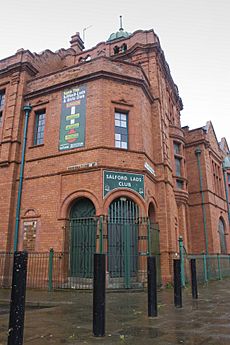
Salford Lads' Club is a famous recreational club opened in 1903. It became internationally known in 1986 when the band The Smiths took a photo in front of it for their album The Queen Is Dead. Experts say it's one of the best examples of its kind of building in England.
Getting Around: Transport in Salford
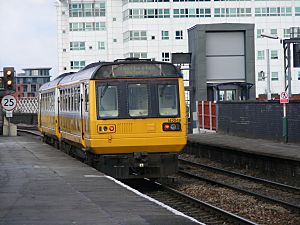
Early transport in Salford included turnpike roads, which were toll roads. These roads made it easier to move goods. Later, canals like the Manchester Bolton & Bury Canal helped transport coal. In 1824, the first bus service started from Pendleton to Manchester.
The Liverpool & Manchester Railway, the world's first steam-powered passenger railway, opened in Salford in 1830. It helped transport goods between Liverpool and Manchester's factories. Almost eight years later, the Manchester and Bolton Railway opened, ending at Salford Central railway station.
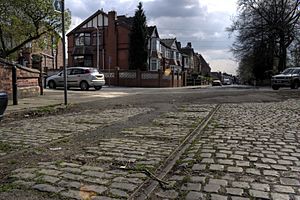
In 1861, the first horse-pulled tramway was built in Salford. Electric trams became common in the early 1900s, replacing horse-drawn vehicles. A network of tram lines connected Salford, Manchester, and nearby areas. However, in 1947, trams were replaced by buses.
Today, Salford has a complex road system with connections to major motorways. Transport for Greater Manchester (TfGM) manages public transport. Salford has two railway stations: Salford Central and Salford Crescent. Buses run to many places in and around Salford.
The Eccles line of the Manchester Metrolink tram system runs through Salford. It has stations at places like Salford Quays and MediaCityUK. The line opened in 1999 and 2000. Since 2020, electric scooters have also been available for hire in central Salford.
Learning and Culture: Education and Institutions
University and Museums: Places of Knowledge
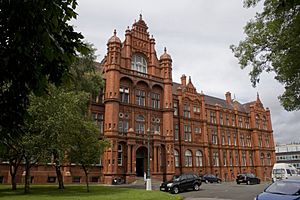
The University of Salford is one of four universities in Greater Manchester. It started as the Royal Technical College in 1956 and became a university in 1967. The university has over 19,000 students. It has invested a lot in new facilities, including a law school and a building for health and social care.
Salford has a history of civic institutions. In 1806, Chapel Street became the first street in the world to be lit by gas. Salford Museum and Art Gallery opened in 1850. It was built on the site of the Lark Hill estate. The library there was one of the first free public libraries in the country.
Schools and Colleges: Learning for All
In 1851, education in Salford was considered not good enough. Many children went to crowded and dirty schools. Today, Salford has 32 primary schools and five secondary schools. There are also colleges that merged to form Salford City College in 2009.
Faith and Community: Religion in Salford
Historically, Salford was part of the Diocese of Lichfield, and later the See of Chester. Early worship took place at Manchester's parish church. In 1634–35, a wealthy merchant named Humphrey Booth opened a chapel. This became the Chapel of Sacred Trinity. John Wesley, a famous religious leader, preached here. The chapel was rebuilt around 1752–53 and is now a very important historic building.
Salford Cathedral is one of the largest Catholic cathedrals in Northern England. It was built between 1844 and 1848. It is the main church for the Roman Catholic Diocese of Salford, which was founded in 1850. The Bishop of Salford's home is at Wardley Hall.
Salford also has many other churches, including St. Thomas' in Pendleton and St Philip with St Stephen. The Greek Orthodox Church of the Annunciation in Broughton was founded in 1861 by Greek immigrants. It is the oldest purpose-built Orthodox church in the UK.
Sporting Spirit: Sports in Salford
Salford has a rich sports history. It hosted some events for the 2002 Commonwealth Games. Horse racing has been held at Kersal Moor since 1687.
Salford Red Devils is the city's rugby league club. They have been based in Salford since 1873 and play in the Super League. Junior rugby league is also popular in Salford. The Premiership rugby union team Sale Sharks also play their home games at the AJ Bell Stadium in Salford.
Salford Quays has been used for major international triathlon events. In the early 1900s, speedway races were held at Albion Stadium.
Salford City is Salford's only professional football team. They play in League Two, the fourth tier of English football. Before their promotion in 2019, Salford was one of the largest UK settlements without a league football team.
Creative Corner: Culture in Salford

Many famous stories and shows are set in Salford. Harold Brighouse's play Hobson's Choice takes place in Salford in 1880. Walter Greenwood's 1933 novel Love on the Dole is also based on Salford. The fictional town of Weatherfield in the soap opera Coronation Street is influenced by Salford. The film East is East was also set in Salford in the 1970s.
The folk song "Dirty Old Town", written by Salford-born Ewan MacColl, gave Salford its nickname. The band Doves released a song called "Shadows of Salford" in 2005. A famous photo of the band The Smiths was taken outside the Salford Lads' Club. The band Happy Mondays and punk poet John Cooper Clarke are also from Salford.
Community Support: Public Services
Salford has its own police force, which became part of the Greater Manchester Police in 1974. The Greater Manchester Fire and Rescue Service provides fire and rescue services.
Salford Royal is a large NHS hospital in Salford. It was rated as excellent in its services in a 2006–07 review. The North West Ambulance Service provides emergency patient transport. Other health care is provided by local clinics.
Waste management is handled by the local authority. United Utilities manages Salford's electricity, drinking water, and waste water.
Famous Faces: Notable People from Salford
People from Salford are called Salfordians. Many famous people have come from the city. Joy Division, a rock band, formed in Salford in 1976. They later became New Order.
Emmeline Pankhurst, a leader of the British suffragette movement, lived in Salford. The scientist James Prescott Joule was born and grew up here. Novelist Walter Greenwood and dramatist Shelagh Delaney were both born in Salford and wrote about the city.
Folk singer Ewan MacColl, who wrote "Dirty Old Town", was born in Salford. Composer Sir Peter Maxwell Davies, who was the Master of the Queen's Music, was also born here.
Famous Salfordian sportspeople include former England football player Paul Scholes. He and other former Manchester United F.C. players bought Salford City F.C.. Eddie Colman and Geoff Bent, two Manchester United players who died in the Munich air disaster, were also from Salford.
Actors Albert Finney and Robert Powell were born and raised in Salford. Journalist Alistair Cooke, known for "Letter from America" on the BBC, was also born in Salford.
See also
 In Spanish: Salford para niños
In Spanish: Salford para niños




